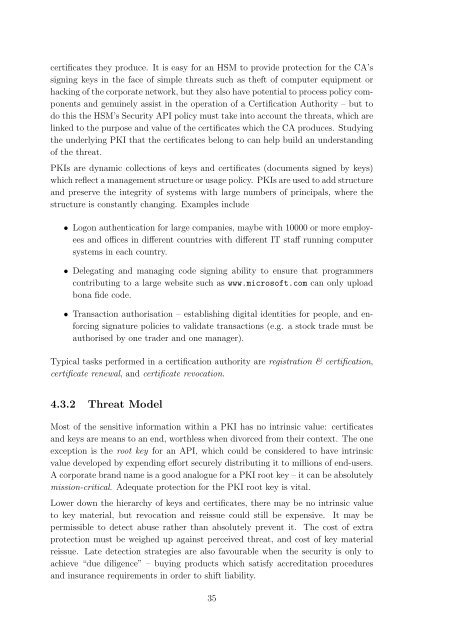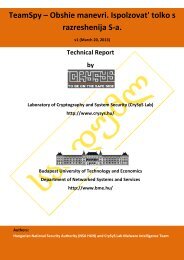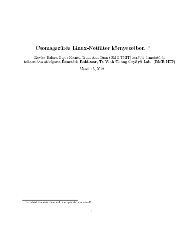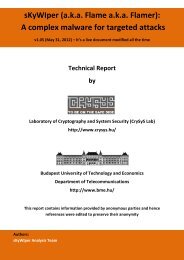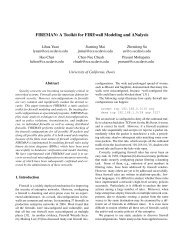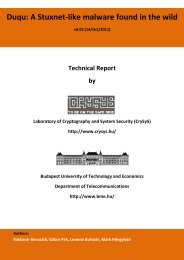Understanding Security APIs - CrySyS Lab
Understanding Security APIs - CrySyS Lab
Understanding Security APIs - CrySyS Lab
You also want an ePaper? Increase the reach of your titles
YUMPU automatically turns print PDFs into web optimized ePapers that Google loves.
certificates they produce. It is easy for an HSM to provide protection for the CA’s<br />
signing keys in the face of simple threats such as theft of computer equipment or<br />
hacking of the corporate network, but they also have potential to process policy components<br />
and genuinely assist in the operation of a Certification Authority – but to<br />
do this the HSM’s <strong>Security</strong> API policy must take into account the threats, which are<br />
linked to the purpose and value of the certificates which the CA produces. Studying<br />
the underlying PKI that the certificates belong to can help build an understanding<br />
of the threat.<br />
PKIs are dynamic collections of keys and certificates (documents signed by keys)<br />
which reflect a management structure or usage policy. PKIs are used to add structure<br />
and preserve the integrity of systems with large numbers of principals, where the<br />
structure is constantly changing. Examples include<br />
• Logon authentication for large companies, maybe with 10000 or more employees<br />
and offices in different countries with different IT staff running computer<br />
systems in each country.<br />
• Delegating and managing code signing ability to ensure that programmers<br />
contributing to a large website such as www.microsoft.com can only upload<br />
bona fide code.<br />
• Transaction authorisation – establishing digital identities for people, and enforcing<br />
signature policies to validate transactions (e.g. a stock trade must be<br />
authorised by one trader and one manager).<br />
Typical tasks performed in a certification authority are registration & certification,<br />
certificate renewal, and certificate revocation.<br />
4.3.2 Threat Model<br />
Most of the sensitive information within a PKI has no intrinsic value: certificates<br />
and keys are means to an end, worthless when divorced from their context. The one<br />
exception is the root key for an API, which could be considered to have intrinsic<br />
value developed by expending effort securely distributing it to millions of end-users.<br />
A corporate brand name is a good analogue for a PKI root key – it can be absolutely<br />
mission-critical. Adequate protection for the PKI root key is vital.<br />
Lower down the hierarchy of keys and certificates, there may be no intrinsic value<br />
to key material, but revocation and reissue could still be expensive. It may be<br />
permissible to detect abuse rather than absolutely prevent it. The cost of extra<br />
protection must be weighed up against perceived threat, and cost of key material<br />
reissue. Late detection strategies are also favourable when the security is only to<br />
achieve “due diligence” – buying products which satisfy accreditation procedures<br />
and insurance requirements in order to shift liability.<br />
35


